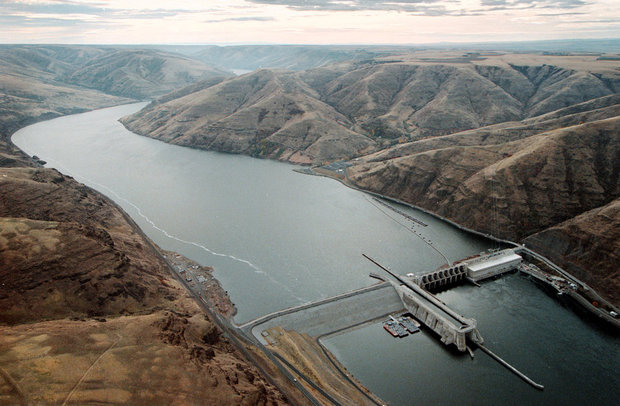the film
forum
library
tutorial
contact
|

|
Washington Gov. Jay Inslee says Dam Breaching Must 'Remain on the Table,'
Benefits of Four Lower Snake River Dams Replaceable
by Eli Francovich
Spokesman-Review, July 8, 2021
|
"I believe it has set us up to take the next step, which is
to define the ways to replace these services for these dams."
-- Washington Gov. Jay Inslee
 SHELTON, Wash. -- Dam breaching must "remain on the table" and the benefits four dams on the Lower Snake River provide can be replaced, Washington Gov. Jay Inslee said Thursday while addressing a gathering of tribal leaders and one federal lawmaker.
SHELTON, Wash. -- Dam breaching must "remain on the table" and the benefits four dams on the Lower Snake River provide can be replaced, Washington Gov. Jay Inslee said Thursday while addressing a gathering of tribal leaders and one federal lawmaker.
Inslee spoke on the second and final day of a "salmon and orca summit" organized by the Nez Perce Tribe and the Affiliated Tribes of Northwest Indians. The tribes have rallied around an ambitious proposal in Congress to remove four dams on the Lower Snake River even as that plan has faced opposition, including from Inslee himself.
However, on Thursday he signaled support for a key plank in Idaho Rep. Mike Simpson's plan -- dam breaching.
"(Simpson's) willingness to offer one path forward has helped bring us to this moment," Inslee said via Zoom. "I believe it has set us up to take the next step, which is to define the ways to replace these services for these dams."
Earlier in the day, Oregon Gov. Kate Brown also spoke in support of the plan that outlines $33.5 billion in federal spending to breach four dams on the lower Snake River in 2030 -- removing earthen berms to restore the river's flow -- and to replace the transportation, irrigation and power generation the dams provide. Simpson's proposal likely won't make it into the multitrillion-dollar infrastructure package that Congress is crafting.
"To get there we need to bring the Northwest delegation together and support full funding for the Columbia Basin Initiative securing (the) 25 to 30 billion (dollars) we need in one of this year's federal infrastructure bills," Brown said. "Once this funding is secured we must urgently work together to ensure that complimentary federal legislation for a comprehensive solution is secured."
Inslee's comments Thursday come after he and Washington Sen. Patty Murray rejected Simpson's proposal in May.
"Regional collaboration on a comprehensive, long-term solution to protect and bring back salmon populations in the Columbia River Basin and throughout the Pacific Northwest is needed now more than ever," Inslee and Murray wrote at that time. "However, a solution must ensure those who rely on the river in the Basin and across the Pacific Northwest are part of the process."
On Thursday, Inslee said any plan has to honor tribal treaty rights, protect native species, provide clean, affordable and reliable energy and protect agriculture interests, including shipping and irrigation. Now is the time to "take the next steps in this regional discussion," he said.
Simpson sat and listened. Following Inslee's and others remarks, he took the stage.
"I appreciate the words of Gov. Brown and Gov. Inslee," Simpson said. "Especially their recognition of the urgency we face in this. It's urgent and you all know that. I look forward to working with them and working with you."
Earlier in the morning, David Johnson, director of the Nez Perce Tribal Department of Fisheries Management, emphasized just how urgent the situation is.
"These fish don't have much time left," he said. "Good ocean. Bad ocean. Now is the time we have to do something big."
Johnson presented the findings from a tribal study first published in May.
The study found, among other things, that wild spring and summer chinook populations are declining by 19% per year. If trends continue, by 2025 77% of the Snake River basin spring and summer chinook populations will be perilously close to extinction. The picture is only slightly less grim for steelhead populations.
The heat wave that's blanketed the Northwest has only made the situation worse, he said. Water temperatures have reached the low 70s in some areas between Portland and Lewiston. Water temperatures higher than 68 degrees are bad for salmon.
In response, river managers reduced flows over Lower Granite and Little Goose dams on July 2. Instead of flowing over the spillways, the water is being shunted through the powerhouse intake which is about 30 meters underwater and thus cooler. However, reduced spill over the top of the dams means more salmon will go through the turbines and it will take them longer to migrate. In response, fishery managers have started trapping and trucking salmon. Managers also started piping cool water from Dworshak Reservoir into the Snake River two weeks earlier than normal and before the reservoir had fully refilled. Water that normally lasts through August could run out early in that month, Johnson said.
"You have one bad year like this, you have two bad years like this, then you don't have anything left," Johnson said. "We're running out of things we can do."
Eli Francovich
Washington Gov. Jay Inslee says Dam Breaching Must 'Remain on the Table,' Benefits of Four Lower Snake River Dams Replaceable
Spokesman-Review, July 8, 2021
See what you can learn
learn more on topics covered in the film
see the video
read the script
learn the songs
discussion forum


 SHELTON, Wash. -- Dam breaching must "remain on the table" and the benefits four dams on the Lower Snake River provide can be replaced, Washington Gov. Jay Inslee said Thursday while addressing a gathering of tribal leaders and one federal lawmaker.
SHELTON, Wash. -- Dam breaching must "remain on the table" and the benefits four dams on the Lower Snake River provide can be replaced, Washington Gov. Jay Inslee said Thursday while addressing a gathering of tribal leaders and one federal lawmaker.
